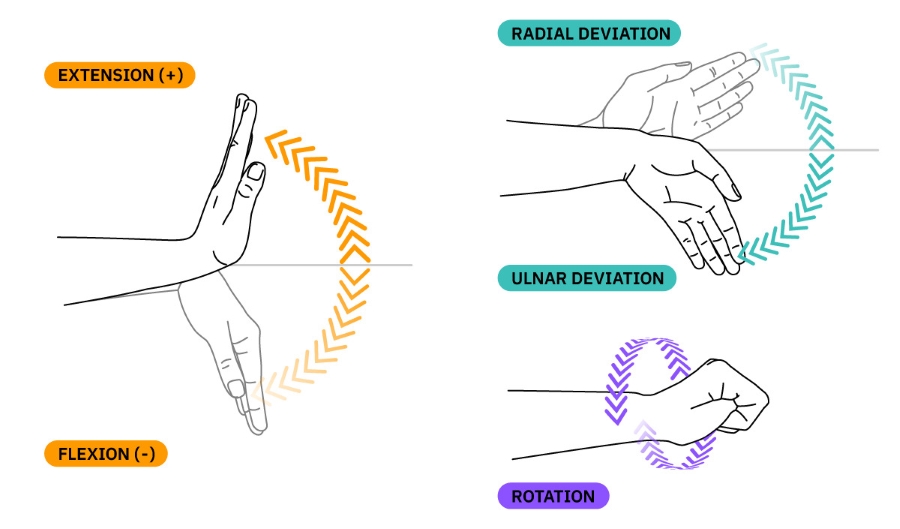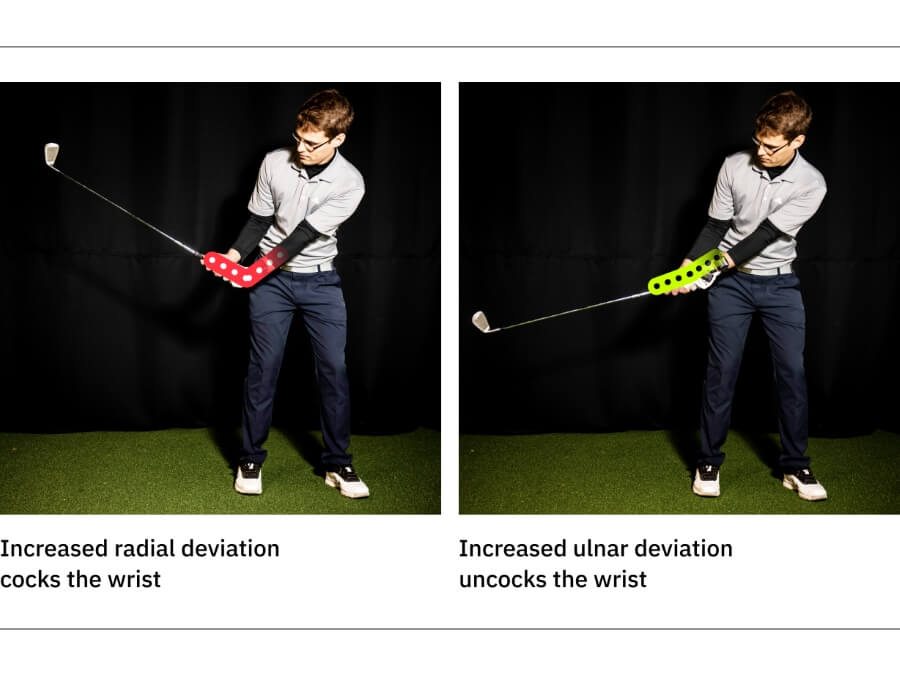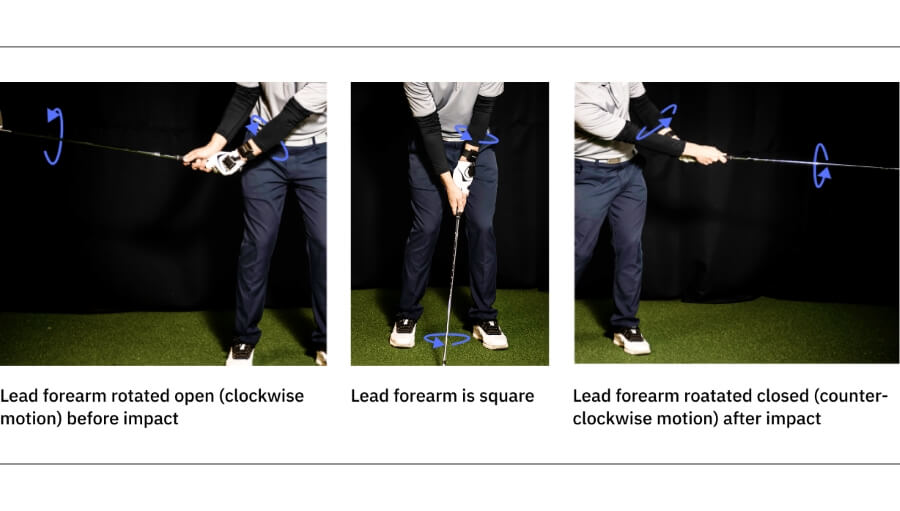Role of Wrist Angles in the Golf Swing
Wrist Action in Golf Swing (Key Takeaways)
After analyzing more than 1,000,000 golf swings, we’ve poured a lot of detail and discovery into the information here. However, if you’re short on time, here are a few of the most essential facts to take with you right now:
- The wrists move in three ways: extension/flexion, radial deviation/ulnar deviation, and pronation/supination.
- Flexion and extension in the wrists are most critical for learning to control the clubface and hit straighter shots.
- The wrist position changes throughout the swing, so it must be correct at setup and at the top of the backswing to have the best chance for a square and solid impact.
- The best way to measure and analyze wrist action in golf is to use the HackMotion wrist sensor and record data at setup, top of the backswing, and impact.
- A quick way to fix slices, hooks, pushes and pulls is to get the proper wrist action in your golf game.
If you prefer to watch instead of read, here’s a recap of all the basics of wrist action. This video from Phil Leathem will help you understand the role of the wrists and how wrist action impacts your golf game.
Contents
What Should the Wrists Do in The Golf Swing?
Before we dive into the role of wrist action in the golf swing fully, let’s start with a basic understanding of what the wrists do in the golf swing.
Your wrists control the clubface.
The wrist that really holds the power in the swing is the lead wrist. For a right handed golfer, it’s the left wrist. Lead wrists should be very close to flat at the top of the swing and close to flat again at the impact position.
There are variations to this based on the type of player, physical characteristics, swing dynamics, etc. However, regardless of the kind of player you are and how long you have been playing the game, your wrists are going to control the angle of the clubface.
Why does that matter?
The angle of the clubface controls where the golf ball goes!
That should be some motivation to stick around and fully understand how you can improve your wrist action in your golf game.
Wrist Positions in Golf (How do the Wrists Move)
Wrist action in golf is best understood when you know how the wrist can move.

Extension/Flexion
Extension and flexion are more commonly referred to as bowing and cupping or arching and bending the wrist.
This is the wrist action that will open and close the clubface. Extension will open the face of your golf club; flexion will close it.
As you swing the golf club, if you can control the extension and flexion in your wrist, you will have more control over the direction of your golf shot.
The easiest way to describe the flexion and extension in the wrist is by holding your arm out in front of you, pulling your hand up so you see your fingers, and then pushing your hand down so they are no longer visible.
Common Issues Seen in Golf
The average golfer tends to hit golf shots with the clubface slightly open. The open clubface causes a slice or an unwanted fade.
Too much wrist extension in the lead wrist (left wrist for right-handed players) leaves the clubface too far open.
From this open position at the top of the swing, it becomes challenging to recover and hit a straight shot. In addition, golfers have to slow down to square the clubface instead of speeding up through impact.
Although bowing or arching your wrist may sound like an issue, your chance of hitting a straighter shot is increased if you can have a little bit of a bow or arch at the top of the swing.

More extension (cupping) opens the clubface and delays squaring it to the target. More flexion (bowing) closes the clubface earlier and helps to square it to the target.
Radial Deviation/Ulnar Deviation
The next wrist movements you should understand are radial deviation and ulnar deviation. To me, it’s easier to think about radial and ulnar deviation as cocking or uncocking of the wrist.
The movement here is more side to side. When you cock your wrist, the thumb gets closer to your forearm; when you uncock, the pinky finger moves closer to your forearm.
Radial deviation increases the wrist cock, whereas ulnar deviation decreases it. This is where the power comes from.
Amateur golfers want to increase the amount of lag they have in their golf swing, and improving wrist cock can do this for you.

Common Issues Seen in Golfers
Radial deviation becomes tricky because the more you add, the more the wrist extends. These two motions happen at the same time in the swing.
Try this now, even without a club in your hand. Move your lead wrist back as though you are taking a backswing, and add radial deviation (or move the thumb towards your forearm). As you do this, the top of your hand is going to move up a bit, therefore increasing extension.
We know that extension (especially too much of it) will open the clubface.
Have you ever really tried to go after a ball and add some more distance with a bit of extra wrist cock? Sometimes this shot goes right, and the wrist action in golf can tell us how and why this happened. As you increase the wrist cock, you also add too much extension.
Rotation (Pronation/Supination)
The third of the key wrist movements in the game of golf is wrist rotation.

If the flexion and extension move the wrist up and down, and radial and ulnar deviation is more side to side, the pronation and supination mean more of a turning of the entire wrist.
In fact, the rotation almost feels like it is more in the forearm than it is in the wrists.
Take your hand and hold it out before you so that your thumb points up to the sky. Now, turn your hand so that your thumb is facing the ground; that is wrist rotation. With this movement, you will feel more like your entire forearm rotates, not just the wrist.
Pronating happens when the rotation of your wrist allows you to see more of the top of your hand; supinating is when you see more of your palm.
Rotation will close the clubface as you approach the impact position, making it very important for consistent long-term golf.
Common Issues Seen in Golfers
The average golfer leaves the clubface too far open at impact. The proper rotation of the clubface would close it and create a straighter golf shot. However, too much rotation in the wrist can cause you to pull the ball.
Final Thoughts
There is a lot of information here about the proper wrist action in the golf swing.
When you look at concepts in golf, wrist action is, without a doubt, one of the most complex.
Now that you understand better, it’s time to get out there with your HackMotion and see what kind of progress you can make.